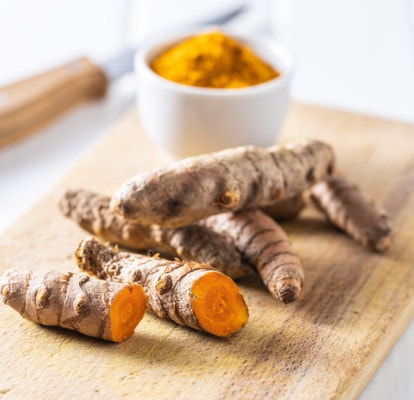Scientists Turn to Curcumin to Find a Better Way to 3D Print Bone?
Of all the myriad of supplements out there, curcumin has been the star of the last few years. While supplements like glucosamine and chondroitin have been quietly adding studies that show they can help arthritis, curcumin has been stealing the show. Now a new study puts this Indian spice back into the spotlight, this time because of its effects on bone health.
Curcumin and Its Many Uses

Jiri Hera/Shutterstock
Curcumin is the active ingredient in the Asian root plant turmeric and is extracted from the rhizomes of the plant. Turmeric is native to India, is actually in the ginger family, and is one of the major spices used in Indian cuisine, particularly curries. With curcumin’s unmistakable mustard-yellow color, it’s also commonly used as a dye. Turmeric has been used in traditional Ayurvedic, Siddha, and Chinese medicine for thousands of years to treat everything from stomach and liver issues to common colds, cancer, and menstrual pain and much, much more.
Curcumin as an Anti-Inflammatory and Antioxidant
Curcumin can also be consumed as a dietary supplement and is known for its anti-inflammatory properties; therefore, it is often taken to help relieve arthritis. In fact, curcumin has been shown to provide arthritis relief as effectively as NSAIDs, such as ibuprofen. Curcumin acts as an anti-inflammatory by blocking inflammatory cytokines (PGE2, IL1-beta, IL-6, etc.) that break down, or destroy, the joint and curcumin is particularly good at reducing inflammation in tendon and cartilage cells, eliminating toxic chemicals in the joint, and rescuing troubled cells before they die.
Curcumin also has very strong antioxidative properties. In fact, studies have shown it can alter oxidative stress effects by as much as 400%. Oxidative stress occurs when the body cannot detoxify the harmful effects of negative free radicals faster than the body can produce them. This means cell damage that leads to aging and illnesses. And curcumin was found to significantly reverse this effect.
It’s important to note that the liver doesn’t absorb curcumin well on its own, so it needs to be taken with BioPerine (a pepper extract) as this is a vehicle that assures curcumin can be properly absorbed. Many curcumin supplements already come with BioPerine in them, but they can also be purchased and taken as two separate supplements.
Study Finds Curcumin Increases Bone Formation
The new study utilized 3D-printed bone scaffolds coated in curcumin to investigate the direct effect of the spice on bone and compared their findings to a control model (no curcumin on the scaffold). Researchers used polymers to provide a continuous release of curcumin over a period of 22 days. The results? Compared to the control, the bone formation on the curcumin-coated scaffolds increased from 29.6% to 44.9%. Researchers also found that the curcumin increased the activity of cells that form bone, called osteoblasts, and decreased the activity of cells that break down bone, called osteoclasts. Additionally, faster wound healing was discovered in the curcumin scaffolds.
While the study focus in this case was on the effect of coating musculoskeletal devices, such as knee or hip implants, in curcumin, the researchers’ ultimate goal is on finding natural alternatives for chemical-laden pharmaceuticals in treating or preventing bone disease as we age, such as osteoporosis, or bone injuries. Osteoporosis, for example, is a bone disease that results when the density of the bone decreases. This can create bone so fragile, than a minor fall can cause a terrible fracture. Osteoporosis is particularly common in women after menopause, and is attributed to bone weakening due to many years of hormonal imbalance, inactivity, and aging.
Curcumin is one of those natural alternatives that has been shown to be beneficial in building bone, and the feature study today certainly seems to support this and is a great launch for further studies on the benefits of curcumin for bone health.
Another Study on the Benefits of Curcumin for Bone Health
This study isn’t the only study I’ve covered regarding curcumin and bone loss. Curcumin was also found to suppress oxidative stress in another study, which resulted in the successful alleviation of bone loss. In this study, the curcumin also increased the formation of osteoblasts (those bone-forming cells) as well as alleviated the loss of bone density.
The upshot? Curcumin is a superstar. So much so that it’s gotten the attention of big pharma. I take it every day, more because of its anti-inflammatory properties, but it’s good to know it helps bones as well.

If you have questions or comments about this blog post, please email us at [email protected]
NOTE: This blog post provides general information to help the reader better understand regenerative medicine, musculoskeletal health, and related subjects. All content provided in this blog, website, or any linked materials, including text, graphics, images, patient profiles, outcomes, and information, are not intended and should not be considered or used as a substitute for medical advice, diagnosis, or treatment. Please always consult with a professional and certified healthcare provider to discuss if a treatment is right for you.
